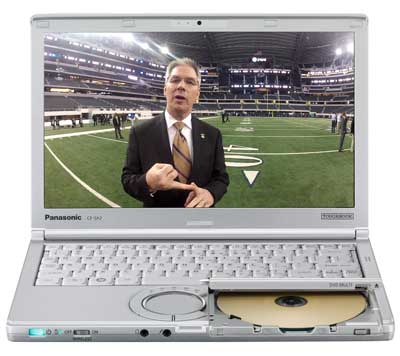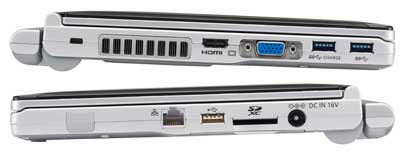|
Panasonic Toughbook SX2
Panasonic's latest business-rugged ultra-light is faster, lower, wider
(by Conrad H. Blickenstorfer)
When it comes to computers, in most parts of the world Panasonic is primarily known for its rugged Toughbook notebooks and tablets. But while the big, burly Toughbook 31, the convertible Toughbook 19, and some of Panasonic's other hardened products are usually in the limelight, the company also has a whole line of what they call "business-rugged" notebooks. Those are really choice selections from a lineup of Japanese domestic market "Let's Note" models that come in a variety of product lines with displays ranging from 10.1 to 15.6 inches.

Let's Note notebooks have a style of their own, one that's very different from the economy notebooks and sleek ultrabooks that are offered in the rest of the world. The Let's Note line is also several notches above your average consumer notebook in terms of quality and durability. You can peruse the Japanese market Let's Note lineup here (it's in Japanese, of course).

While in Japan there are currently A (11.6"), B (15.6"), J (10.1"), NX (12.1) and SX (12.1") series Let's Note models, only C, F and S versions have morphed into Toughbook branded versions available in the US. Letter designations come and go, and models change frequently, so it isn't easy to keep track of the lineup. Which is regrettable as they are all fascinating machines that deserve more attention. But let's move on to the new SX2.
As is, on October 11, 2012, Panasonic introduced the Toughbook SX2 in the US. The new model will almost certainly replace the still listed S10. And if you wonder why it's called the SX2, it's because in Japan there's also an SX1 equipped with a second generation Intel Core processor whereas the SX2 has a third gen "Ivy Bridge" processor and technology.
Business-rugged?
Panasonic calls those emigrated Let's Note laptops "business-rugged." What does that mean? In Panasonic's terminology, it describes notebooks that are designed for mobile professionals and road warriors who require machines that can handle the stress of frequent travel and constant movement. Panasonic's business rugged computers use some of the same technology as their semi-rugged and fully rugged machines, but they are built to handle minor spills and drops as opposed to a passing a a long list of military specs.
So the SX2 can handle repeated 3-foot drops (like falling off a desk), 220lbs of pressure evenly distributed over its surface (like getting crushed), and withstanding the effects of vibration (like being on a crowded train). There isn't a stated operating temperature range or an IP sealing number (the ports are all open and have no plugs).
This all probably doesn't the SX2 full justice as at least on the Panasonic Japan website, there is ample reference to all the design concepts that make the SX2 tough, like wrap-cushioning around the hard disk, endurance testing for the LCD hinge; "floating" support of key components such as the LCD, PCBs, and keyboard; force-deflecting design of the housing and structural parts, and so on. Anyone who has ever held a Toughbook of Let's Note origin knows what all this means: unlike the very rigid heavy-duty Toughbooks, these products are light and intentionally flexible.
That's all by design. It's the very flexibility that provides the protection. And there are other clever design features. The characters on the keys are laser-cut so that they don't wear off. A palm sheet provides wear resistance and is cooler to the touch. The LCD case is designed so it won't twist on impact if it falls. The SX2 is a Toughbook, but a Toughbooks that only weigh three pounds and is designed to fend off what might happen during a typical business day.
Unique design
The Toughbook SX2 is truly unique. While Panasonic emphasizes that the SX2 is 33% thinner than the previous model (presumably the S10), it's still twice as thick as a MacBook Air or an Ultrabook. However, thanks to Panasonic's vast experience with lightweight magnesium alloy construction, the SX2 actually weighs hardly more than a 13" MacBook Air or Ultrabook. That's amazing given that the SX2 has an integrated optical drive and an extremely powerful 98 watt-hour battery good for up to 14.5 hours of operation. That's roughly twice what a MacBook Air or most Ultrabooks can do on a charge.
The SX2's 12.1-inch display offers 1600 x 900 pixel resolution — that's wider and higher resolution than the predecessor S10 that had 1280 x 800 res. There is no touch screen, but Panasonic's unique and very precise circular touch pad provides extra functionality, hopefully enough to work well with Windows 8. The 84-key keyboard is full-scale, which is certain to be appreciated by touch-typists. Letters and symbols are dark gray on very light gray and easy to read.
What's new?
Compared to the S10 that it eventually replaces, the S2X doesn't look much different, but it actually represents a good step forward. The above-mentioned higher resolution in the increasingly dominant 16:9 aspect ratio makes the device more suitable for video playback, today's more complex websites, and it also looks more contemporary. The noticeably thinner profile will be welcomed by anyone who needs to stow away an SX2 in an attache case or travel bag. The 2.5GHz third-gen Intel Core i5-3320M processor and its complementing QM77 chipset are a considerable step forward both in speed (especially graphics) and economy where the new chip design provides enhanced power management. And the new chipset's native USB 3.0 and PCIe 3.0 support helps eliminate throughput bottlenecks.
There now two USB 3.0 ports in addition to a USB 2.0 port. WiFi stays with Intel Centrino Advanced-N 6205 but Bluetooth is now version 4.0, RAM is of the power-saving DDR3L variety, and there's now a 720p webcam. The old RJ11 modem port has faded into history, as has the older version's PC Card slot. Curiously, no mention on available WWAN.
One thing US customers won't get is a smartphone interface that communicates with the SX2 via WiFi so you can synchronize and edit Office documents, view the desktop and use/operate the SX2 when it's not convenient to open it. That currently only works on some DoCoMo phones.
Bottom line
We've always liked the Toughbook W and S Series, all the way back to initial W2. The line combines small size, light weight, and now excellent performance with exceptionally long battery life. There's the onboard optical drive and the SX2 excels in the connectivity department. It's a mature, very competent design that brings the Toughbook brand to business customers. This latest iteration now uses Intel's very latest third gen Core i5 chips as well, so we're technologically up-to-date. The high resolution, wider format display will certainly be appreciated. And Panasonic has even flattened out the predecessor's rather bulky profile, though fashionably slender design remains a moving target.
Here are the remaining problems with the SX2: First, the design is very obviously meant to hold up to Japanese subway traffic and office mishaps; naming it a Toughbook without at least retrofitting the ports with some protection and running at least a few of the industry standard military tests and issue temperature and sealing ratings does not seem quite enough. Second, starting at US$2,649, the SX2, even with its exceptional battery life and update tech, is expensive. Compared to salaries, of course, price is relative, and Panasonic's vaunted low failure rate may well make up for the higher price of entry.
Overall, a welcome, useful addition to the Toughbook lineup.
|



